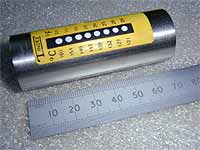SPECIFICATION OF THE 011299 ±12V 150°C SWITCH MODE POWER SUPPLY
LAST REVISION AND DATE: REV03. 22/01/2001
01-1-1-9-9 Electrical Specification at 150°C
DC input voltage range: (See note 1). 12V to 150V
AC input voltage range: (See notes 1+ 2). 12V to 100V RMS
Output voltage 1: +12V (± 1%)
Output voltage 2: -12V (± 1%)
Output current 1: +200mA
Output current 2: -200mA
Output power: 4.8 Watts
Output noise: (See note 3). 100mV RMS
Minimum thermal shutdown temperature: 160°C (See note 4)
Short circuit protection: Continuous
01-1-1-9-9 Maximum Specification at 150°C (See note 5)
DC input voltage range: (See note 1). 12V to 170V
AC input voltage range: (See notes 1+ 2). 12V to 120V RMS
Output voltage 1: +12V (± 1%)
Output voltage 2: -12V (± 1%)
Output current 1: +250mA
Output current 2: -250mA
Output power: 6 Watts
Output noise: (See note 3) 125mV RMS
Short circuit protection: Continuous
Mechanical Dimensions
Mechanical dimensions and tolerance are detailed in drawing 01-1-1-9-9.
Pin Out
Inputs and outputs are described by drawing 01-1-1-9-9.
Encapsulation
All power supplies are encapsulated to improve the mechanical strength of the case and protect the supply from the drilling environment.
Temperature
The operating temperature range shall be -21°C<TEMP<151°C. The maximum rate of change of temperature shall not exceed 5°C per minute. Survival temperature shall be 175°C, operating.
Operating Environment
The power supply will continue to meet this specification for one thousand hours at 150°C. Minimum life expectancy within a 150°C oil field environment shall be one thousand hours.
Qualifying Vibration Test
Either powered or unpowered, the power supply shall survive the following qualifying sine vibration test at ambient temperatures. 20g rms for four hours per axis, swept sine from 10Hz to 2KHz. Three tests in all for a total of twelve hours.
Alternatively, the unit shall survive a random vibration test of 20g rms for four hours per axis at 0.2g² per Hz from 10Hz to 2KHz. Three tests in all for a total of twelve hours at ambient temperatures.
Screening Vibration Test
Either powered or unpowered, the power supply shall survive the following screening sine vibration test at ambient temperatures. 10g rms for four hours per axis, swept sine from 10Hz to 2KHz. Three tests in all for a total of twelve hours.
Alternatively, the unit shall survive a random vibration test of 10g rms for four hours per axis at 0.05g² per Hz from 10Hz to 2KHz. Three tests in all for a total of twelve hours at ambient temperatures.
Qualifying Shock Test
The power supply shall survive three shocks per axis. Each shock shall be 1000g, 0.5ms half sine wave. Nine shocks in total.
Screening Shock Test
The power supply shall survive one shock per axis. Each shock shall be 1000g, 0.5ms half sine wave. Three shocks in total.
Shock and Vibration Life Expectancy
Screening levels of shock and vibration will not cause power supply failure within one thousand hours service life.
Humidity
Because the input and output pins are exposed, it is the customer's responsibility to ensure these terminations are properly sealed against moisture after manufacture into their equipment.
Thermal Shutdown
Thermal shutdown shall not occur below 160°C with the power supply fully loaded and the input voltage at 40V. The power supply is capable of supplying a regulated output above 160°C, but this depends upon output load and input voltage. Above an ambient temperature of 150°C output performance is not guaranteed. See performance envelope for clarification.
Notes
1) The minimum start up voltage is 12V, but may be higher for high output loads.
2) Three phase generator specification.
3) Output noise is quoted with an output capacitance of 35µF internal to the power supply and a noise measurement bandwidth of 10MHz.
4) The power supply is designed to monitor its own internal temperature and shutdown if it exceeds a safe maximum. Once cooled, the power supply will self start. The minimum shutdown temperature is 160°C for an input supply of 40V and an output load of 200mA.
5) To avoid premature failure of the power supply, it is the customer's responsibility to ensure these maxima are not exceeded for more than five minutes at 150°C. The high voltage maximum must never be exceeded.
Top of page |


